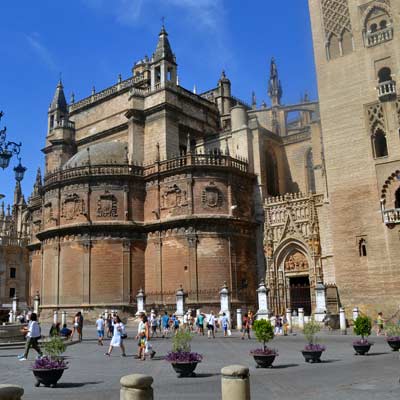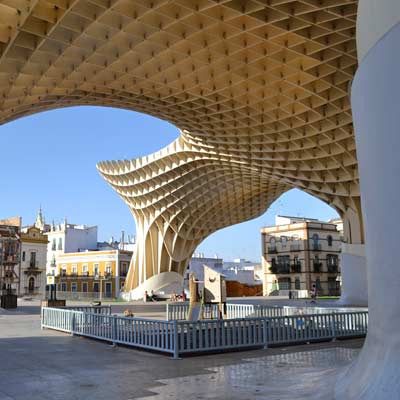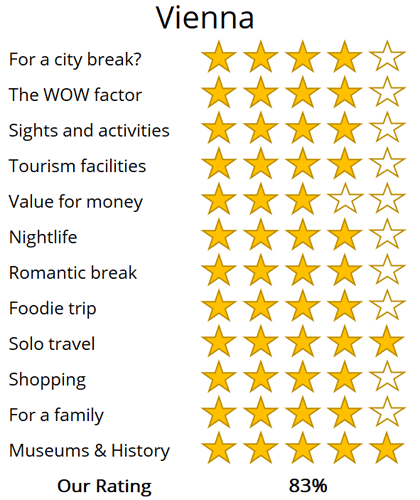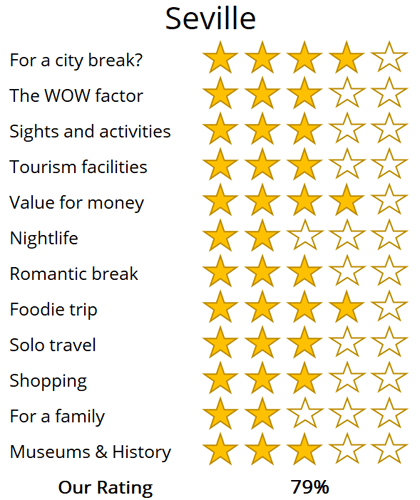WhereToGoForMyHoliday.com
The best destination comparison site!
WhereToGoForMyHoliday.com
The best destination comparison site!
Vienna or Seville, which is better for your holiday in 2024?
Seville and Vienna both offer unique and enticing experiences, but which one should you choose for your city break or holiday?
We recognise the difficulty in making this decision. While there is abundant information available on both destinations, clear guidance on which city better aligns with your travel preferences is often hard to find.
This article aims to provide an impartial comparison of Seville and Vienna, and hopefully help you to choose the best city to visit.
The article is structured into several sections, each of which can be directly accessed through the following links:
• Introduction to the cities
• Scores and ratings
• Which one should I, friends, or family visit?
• When to visit and weather
• Who is the city suited for?
• The perfect 48hours (with map)
• Tourism details (where to stay? airport details?)
Introduction to Vienna and Seville
Seville as a destination reflects that of the city’s famous dance, the flamenco; it is hot, passionate and instantly captivating. Seville boasts exceptional tourist attractions , and it’s rich cultural heritage will leave you longing for more.
Modern Seville is the interplay of its turbulent past, blending together Moorish roots and Christian influence in a city which wants to enjoy and embrace the present. Seville’s heritage is proudly displayed throughout the city, from the magnificent Alcázar palace, to the towering cathedral, mouth-watering tapas restaurants and impromptu flamenco dances.
Strangely, Seville typically lacks the appeal to the younger generation of tourists, but chance a trip and fall in love with the flare of southern Spain.
The erstwhile epicentre of the great Habsburg empire, Vienna, is just as grand and glorious as you might expect. The Hofburg palace spreads is vast Baroque wings in the heart of the town, framing manicured gardens topped with equestrian statues. There's the Belvedere, a patchwork of orangeries and old court rooms. There are opera houses and theatre rooms and the elegant façades of the Schönbrunn. It's enough to keep the camera a-clicking for several days.
But Vienna isn't only about 18th-centry grandeur. This is a lived-in European capital. It's got gritty nightlife districts that offer up beating boat bars on the Danube. It's got handsome parks packed with pine forests and duck ponds. There are vibrant markets with food from all around the globe. And you've got one of the world's most active café cultures, with coffee shops where the likes of Freud and Trotsky were once regulars.

The classic skyline view of Vienna from Saint Stephen’s Cathedral, with its uniquely tiled roof

The Torre del Oro once guarded the Guadalquivir river and Seville
High-level summary for Vienna and Seville
Summary
Where would I journey for a personal escape? Vienna
Where would I send my parents for a memorable visit?
Vienna
Where's the ideal destination for my adventurous 19-year-old cousin?
Vienna
Where should my food-obsessed friend indulge their culinary passions?
Seville
Note: The above comparisons are weather-independent and are based on travel during the most opportune times of the year. Details about the ideal travel seasons are elaborated upon later in this article.
In the sections that follow, you'll find a comprehensive comparison between these two fascinating cities. This includes recommendations on the duration of stay, the best times to visit, and tailored 48-hour itineraries for each city.
The final segment delves into practicalities for your travels, such as the best airport to fly into, the optimal districts for your accommodation, and insider tips, for when you come to explore the city.
We hope that you find all of this information useful, in planning your next exciting trip!
Destination details
How long to spend each city?
Vienna is big and brimmingwith sights. History buffs and culture vultures will want at least three or four days to check off the bucket-list attractions. That's because the mainstay palaces and the most immersive museums each deserve at least half a day to themselves. You'll also need some time to wander the Old Town area and hop the famous Viennese cafés.
If you're eager to explore all of the facets of Vienna, then you'll certainly need much longer than just your average city break. Whole weeks can be spent enjoying the buzzy squares and the statue-filled parklands. What's more, there are day trips aplenty in the region, ranging from the pine forests of the Wienerwald to the rising foothills of the Salzburger Alps.
Seville calls for a more unhurried exploration to truly soak in its relaxed pace and tapas culture. Two days in Seville allow for a comprehensive sightseeing experience, though a single, brisk day could cover the essentials.
Be mindful of the extreme summer heat, necessitating an earlier start to your day and a slower pace.
For those looking to venture beyond, day trips to historic Cordoba, the coastal city of Cadiz, or the dramatic Pueblos Blancos are worthwhile, though the latter may require a rental car or guided tour due to limited public transport options.
Insight: While Granada is a captivating destination, it is best experienced as part of a longer itinerary, perhaps alongside Seville and Málaga, for a fulfilling week-long holiday.

The Schönbrunn Palace, Vienna one of the grandest palaces of central Europe

The Gothic Catedral de Sevilla
Vienna in the summer can't be beaten. When the sun shines, the city's parks and bars come alive. The best weather is usually between June and August, but beware that things can get hot and humid, with temperatures cranking up over 30 Celsius. The good news is that there are some strands and swimming spots along the Danube for cooling off. If you prefer things a little milder, May and September are usually also dry and warm.
On the flip side, Vienna in winter is a real wonderland. The Austrian capital hosts some of the most enchanting Christmas markets in Europe. You'll find those brewing up hot chocolates and mulled wine on Rathausplatz and in the grounds of the Schloss Schönbrunn. They get into full swing in December, when it's common to get dustings of snow and sub-zero temperatures – boots and woollies will be required.
The best time of year to visit Seville is during the two festival periods of Semana Santa (held in the week before Easter) and the Feria de Abril (starting two weeks after Easter).
For a regular trip, late autumn and early spring are the best seasons, as during the long summer (June-September) the city is oppressively hot. Winter provides good value and fewer tourists but there is always the potential of rain.
Seville is a pleasure to visit, so long as you can either handle (or avoid) the extreme heat. This is a city for a slower paced trip, to enjoy time in the open-air cafes and to embrace the culture of Andalusia. This makes the city ideal for a break from a stressful lifestyle or hectic work schedule back at home.
The ambience typically appeals to a slightly older visitor, but to assume Seville is a mature destination would be completely wrong. There are exciting tourist attractions, a colourful nightlife and a social atmosphere. One of the appeals of Seville is that it is not a common city break and few of your friends will have been there.
Packing in handsome palaces, Austrian beer houses, Alpine forests, cool cafés, art-filled galleries, and a buzzy nightlife, Vienna satisfies all sorts of travelers. You can easily fill whole trips in the museums alone. Days can be whiled away flitting between coffee shops. Nights can be spent in opera shows or glugging frothy beers in hipster bars.
Don't go thinking that Vienna is the great Austrian outdoors. This might be the country of the Alps, but the mountains are still at least an hour's train ride to the west. What's more, there's not a beach in sight. The best that landlocked Central Europe can offer in the way of sand and water is a few artificial swimming areas along the River Danube.

The cascade fountain at the Belvedere, Vienna

The Plaza de España is always a highlight of Seville
48hours in Vienna
So, you only have two days in the Austrian capital? Get ready for an itinerary that's packed to bursting with all sorts. From Neo-Classical Habsburg mansions to strolls on the Danube canals to mornings in buzzy market areas, there's something for a whole host of traveler types in these parts.
Day 1: Morning on the Heldenplatz. This manicured urban garden is one of the most iconic squares in Vienna. The huge equestrian statue of Archduke Charles of Austria is what will probably catch the eye but remember that the plaza was also the place where Hitler announced the annexation of Austria in 1938. Nearby, the Hofburg stands proud.
On a quick, two-day itinerary, it's probably best not to delve inside. The exhibits can easily take hours on end, though it's a must if you're a lover of 18th-century European history. Take your photos of the mighty Neo-Classical exterior and then move straight to the streets to the west. They herald the Innere Stadt (the Old Town) of Vienna. Cobbled lanes and little archways form a maze here that's lovely to get lost in. A lunch stop (read: strudel stop) at Café Central is a doozy. Gold-leafed ceilings and elegant royal portraits gild the interior, though the main draw is sitting where Freud and Trotsky once sat sipping their coffees.
Later on, head north around the ring roads to the Sigmund Freud Museum. It's a fine introduction to the life and works of the founder of psychoanalysis, with the original doctor's couch that his patients would sit on. Beeline straight to Prater when the evening closes in. You can get there on the underground, emerging into Vienna's famous inner-city theme part with its twirling Ferris wheel and fairground attractions.

The Prater amusement park with its traditional rides and the Wiener Riesenrad Ferris wheel
Day 2: The early hours on the Naschmarkt offer some of the best people watching in the city. Fruit sellers call out prices while locals chow down on pretzels and white beer in the stalls. This vibrant bazaar is also the perfect place to grab any Viennese souvenirs and foodstuffs. A ubiquitous fix of palaces comes next. We'd recommend choosing one of the big two – the Belvedere Palace or the Schönbrunn. Both are stunning but the former is the easiest to get to. Both will also likely take a couple of hours, especially if you want to explore the sprawling grounds as well as the interior court rooms of the old Habsburg elite.
That will still leave some time in the afternoon to breeze over to the Danube Canal. Abuzz with boat bars and hole-in-the-wall eateries, it can help balance out the culture with a little hedonism. The district of Leopoldstadt is right behind, replete with hipster coffee joints and cocktail emporiums. An alternative way to cap off your weekend could be a jaunt to the hills of the Vienna Woods (the Wienerwald). They offer lookouts – and gorgeous sunsets – above the capital just behind the area of Hütteldorf.

Vienna is not just historic relic, there are modern curiosities such as the Hundertwasser House, designed by an artist who wished no straight lines in his building......
Below is an interactive map for 48 hours in Seville; day 1 is highlighted in green and day 2 in yellow, with optional sights in grey.
Start the day in the impressive Catedral de Sevilla, and climb to the top of La Giralda bell tower for a wonderful viewpoint. Surrounding the cathedral is the atmospheric Santa Cruz district, with its traditional houses and narrow cobblestone streets, which follow the old medieval layout of the city.
For the afternoon, visit the grand Plaza de España and the adjoining Parque de Maria Luisa. Towards the end of the day join a cruise along the Guadalquivir River. For dinner, head to the Triana district for an authentic Tapas meal. This district is also where flamenco dancing originated, and one of the bars may well have some impromptu dancing happening during the evening.

The gardens of the Real Alcázar palace
For the second day, start by visiting the Real Alcázar palace, the finest example of Mudéjar architecture which fuses Arabic and Christian designs. For the afternoon, head north of the historic centre and explore the popular shopping streets of Calle Sierpes. End the afternoon at the Setas De Sevilla, a massive wooden structure and great viewpoint.
In the evening, watch a flamenco performance at the La Carbonería.

The Setas De Sevilla is the world’s largest wooden structure, but few know what it actually is or the point of it……
Seville airport (SVQ) is 10km northeast from the city centre, and is connected by a regular bus service (35min €4.00). Many of the low-cost airlines focus on the coastal cities of southern Spain instead of Seville, which means the cost of flights can be surprisingly high - plus there are fewer departures. This means that demand for flights can be very high in summer (when the city is best avoided).
This high level of tourism also means that hotels tend to be more expensive than much of Spain, and it’s likely you will spend much more than you anticipated! If you are lucky enough to visit during the two festivals, book your accommodation well in advance. Seville is compact and very easy to explore on foot.

The Maestranza bullring; bullfighting is an important tradition in Seville
Vienna is among the safest and most liveable cities in the world – at least if the stats are to be believed. Of course, you'll need to have your wits about you as if you were traveling anywhere. Pickpocketing, fake tour guides, and taxi scams do occur, though they aren't common as in other European capitals.
Getting around should be a cinch in the Austrian capital. The U-Bahn is ridiculously efficient. It links with above-ground rail lines and trams on a single-ticket network to make going from A to B a pleasure, not a chore.
Single trip fares sit at €2.40, while a 48-hour travel card costs €14.10. Don't be tempted to ride the subway without buying tickets. This is possible because the platforms aren't gated, but there are regular checks and hefty fines to match.

The Gloriette is situated on one of the highest points of Vienna and provides one of the best views of the city and the Schönbrunn Palace.
The best arrival point for those flying is Vienna International Airport. It's a well-equipped, modern port on the south-eastern side of the capital. Direct S-Bahn trains link the centre to the terminals, or you can hop on the premium Railjet from Vienna Hauptbahnhof. There's also a shuttle link provided by AirportLines Bus, costing €13 per person, return.
Picking hotels in Vienna can sometimes be a tricky business. First-time visitors can't go wrong if they aim to stay in the Old Town (the Innere Stadt), but rooms there can be pricy and sell out fast. Good alternatives include the hip and happening district of Leopoldstadt (great for dining with a youthful vibe) and any of the blocks that come off Naschmarkt.

oh we were stuck in the airport!

Copenhagen was a bit expensive...

All we did was drink beer in Brussels...

Muncih was crazy

And we got so burnt!

Remeber that night in Rome

oh we were stuck in the airport

So much fun kayaking

Berlin and that group from Austria!

There was such a view from that church

And we got so burnt!

Munich was eventful, wasn't it!

Such a view from that cathedral in Florence

Lisbon was such so much fun

Last summer was so much fun .... x

Remeber that night in Rome

Lisbon was such so much fun

Such a view from that cathedral in Florence

Munich was eventful, wasn't it!

And we got so burnt!

Remeber that night in Rome

All we did was drink beer in Brussels...

Berlin and that group from Austria!

Can't wait to go back to Dubrovnik

Remember that boat ride in Prague

Copenhagen was a bit expensive...








